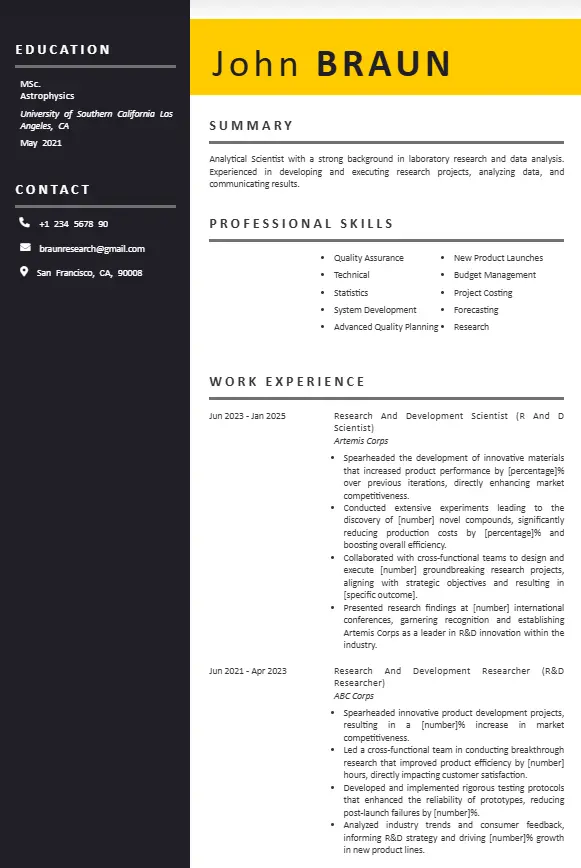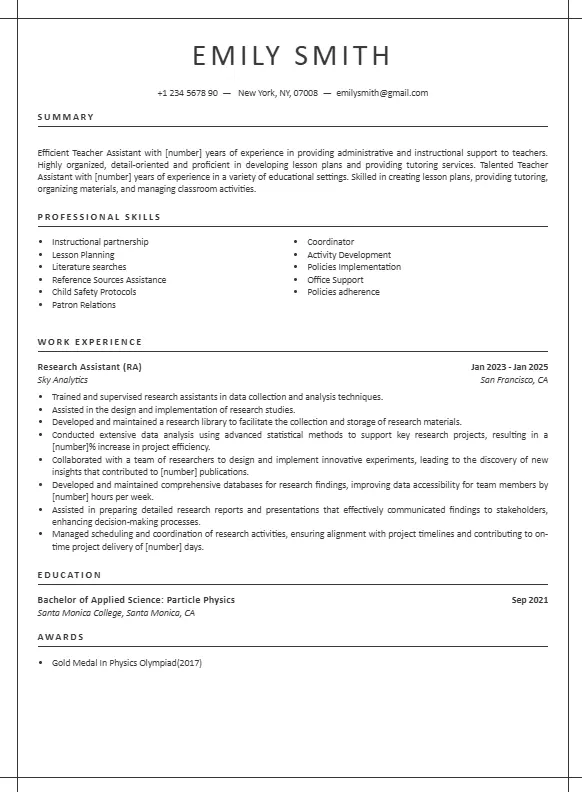Do you want to get your dream Research assistant job? If yes, keep in mind that first impressions matter. But for a job application, what is your first impression? It’s definitely your resume. Hiring managers get piles of resumes in soft or digital forms so how can your resume stand out from the crowd?
You must know that any hiring manager would not read through the entire resume description. They will simply scan through all your content. It should pitch them at first glance!
To land any reputable position in academia, or a research lab, spend time and effort to craft the best possible resume that HRs cannot resist. A well-crafted resume not only highlights your technical abilities but also demonstrates your communication skills, problem-solving aptitude, and ability to work within teams.
Now, let’s come to the most asked question: how to write a research assistant resume that gets you the job. Let’s begin without any delay!
Sections of a Research Assistant Resume
1. Contact Information
The contact information section is the first part of your resume that mainly comes as the header. This must be clear and professional. It will cover all essential details such as your full name, phone number, email address, and links to your professional profiles (e.g., LinkedIn or personal research website). Make sure your contact information is easy to find and up to date. Cross-check all information before you finalize the resume as a little error can cost you a job.
Pro Tip: Include a personal website as a portfolio – it can be a good start to the resume.
2. Summary or Objective Statement
This is the part that hiring managers mainly read properly. It is a two to three-line statement that sums up your entire personality and experience. This concise summary or objective statement provides an overview of who you are and what you aim to contribute as a research assistant. If you have prior experience in your niche, write a summary. It will work best to highlight your achievements and expertise.
Yet, if you are an entry-level candidate, you can go for an objective statement. It must highlight your career goals and how you want to apply your academic background in a research role.
3. Skills
A common mistake that beginners make is mentioning the hard skills only. The skills section must list hard and soft skills that are relevant to the role. Hard skills imply technical competencies such as proficiency with data analysis software, or laboratory techniques. Soft skills are personal factors that relate to how you work. It can include communication, time management, and teamwork. Dont neglect the power of soft skills. They are equally important and should be included if they are strengths you possess.
Research Assistant Resume Skills:
- CRISPR-based techniques
- Molecular cloning
- RNA isolation and analysis
- Data analysis and interpretation
- Flow cytometry
- Literature review and research synthesis
- Laboratory equipment maintenance
- Quality control and assurance
- Experimental design and execution
- Statistical analysis using tools like R or Python
- Gene editing and transfection techniques
- Biochemical and biophysical assays
- Cell culture and maintenance
- Presentation and report writing
- Collaboration and teamwork in research projects
4. Professional Experience
The professional experience section is where you highlight your past roles or internships. You can even mention academic projects that represent your capability as a research assistant. Use bullet points to describe specific duties or accomplishments.
Bullet points make the content easier to scan without wasting much time. The main heading should show your role, followed by a subheading that shows the timeline. In the experience section, the latest experiences are always mentioned at the top.
Pro Tip: Quantify your achievements where possible, as numbers give concrete evidence of your contributions.
5. Education
Mention your academic background, including your degrees and majors, in this section. It will include any special honors or awards. Highlight these achievements in a heading followed by a brief description. Don’t make the description too long. If you have worked on some big projects or research during your studies, mention those in the Education section. Plus, you can highlight any relevant coursework or certifications that connect to the research field.
6. Certifications and Training
Include any certifications that represent your qualifications as a research assistant. This could include laboratory safety certifications or software proficiency certifications. You can mention any specific training in research ethics and methods. These demonstrate your devotion to maintaining high standards in your research practices.
7. Publications and Presentations (Optional)
If applicable, you can include any published papers or presentations at conferences. This is highly important if you’ve co-authored research papers or have had the opportunity to share your work at academic events. Listing these achievements will establish your credibility in the research community.
Pro Tip: Though this is an optional section, including this that differentiates your resume and gives you a plus point!
8. References
In some cases, You can include references or state that they are available upon request. References are the people who can speak to your qualifications or research abilities. Mostly, these are the professors, or supervisors who have observed your work in academic or professional settings. If you have worked under a well-known professor in your major, you must include his/her name. This can be an advantage!
Research Assistant Resume Examples
To help you visualize how to apply the tips and structure discussed above, here are some sample resume sections for a Research Assistant position. These examples cover various aspects, including the summary, skills, experience, and education, to give you a better understanding of how to craft each part of your resume effectively. Feel free to adapt these examples to your background and the specific research role you are applying for.
Example : 1

Example : 2

Tips to Make Your Research Assistant Resume Stand Out
- Modify Your Resume for Every Job: Modify your resume to match the job description. Highlight relevant skills and experiences that align with the research project or lab you are applying to.
- Focus on Achievements: Dont simply list your duties. Your focus should be on specific achievements or contributions you have made in every role. Quantify your results to provide concrete examples of your success.
- Use Action Verbs: Action verbs like “analyzed,” “conducted,” and “designed” make your achievements sound more impactful. Refer to a comprehensive action verbs for resume list to find more powerful words that fit your experience.
- Keep It Concise: A Research Assistant resume must be one page for those with less than five years of experience and a maximum of two pages for those with more extensive experience.
- Highlight Transferable Skills: If you are transitioning into research from another field, focus on transferable skills such as analytical thinking, communication, and project management that can be applied in the research setting.
- Include Relevant Software: Many research assistant roles demand knowledge of specific tools, such as statistical analysis programs (e.g., SPSS, R), data visualization tools (e.g., Tableau), or laboratory software. Make sure to list any relevant software you are proficient in.
- Proofread: A resume with typos or grammatical errors can hurt your chances. Proofread your resume multiple times, or ask someone else to review it for you. Multiple tools are available online to get a professional resume review!
Common Mistakes to Avoid
Here are the top mistakes that people make while writing their research assistant resume. You must avoid them to increase your chances of getting hired. Let’s take a look!
- Using generic language instead of highlighting specific achievements or skills.
- Overloading the resume with unnecessary details or irrelevant experiences.
- Failing to modify the resume for the specific research assistant position being applied for.
- Ignoring the job description and missing out on including keywords relevant to the role.
- Using inconsistent formatting, fonts, or spacing makes the resume look unprofessional.
- Forgetting to proofread for spelling, grammar, or typographical errors.
- Submitting a resume that exceeds one or two pages
- Using vague job titles or descriptions that fail to demonstrate responsibilities.
- Including personal information like age, marital status, or a photo, unless specifically required.
- Writing responsibilities instead of focusing on accomplishments or impact.
- Submitting the resume in an unprofessional format like a Word file instead of a PDF.
Wrap Up!
A well-structured Research Assistant resume is a must-have to land a position in this strong and reputable field. The competition is strong, so you have to work hard and set your resume apart from the competitors. Present all your skills, experience, and qualifications. This way you can demonstrate to potential employers that you have the capabilities to contribute to their research team in a meaningful way. The best advice is to modify your resume for every application. You must emphasize measurable achievements, and keep your document professional and concise. Follow the above guidelines, so you will increase your chances of standing out for the research role you desire!
Additional Resources :- 100+ technical skills for resume examples

